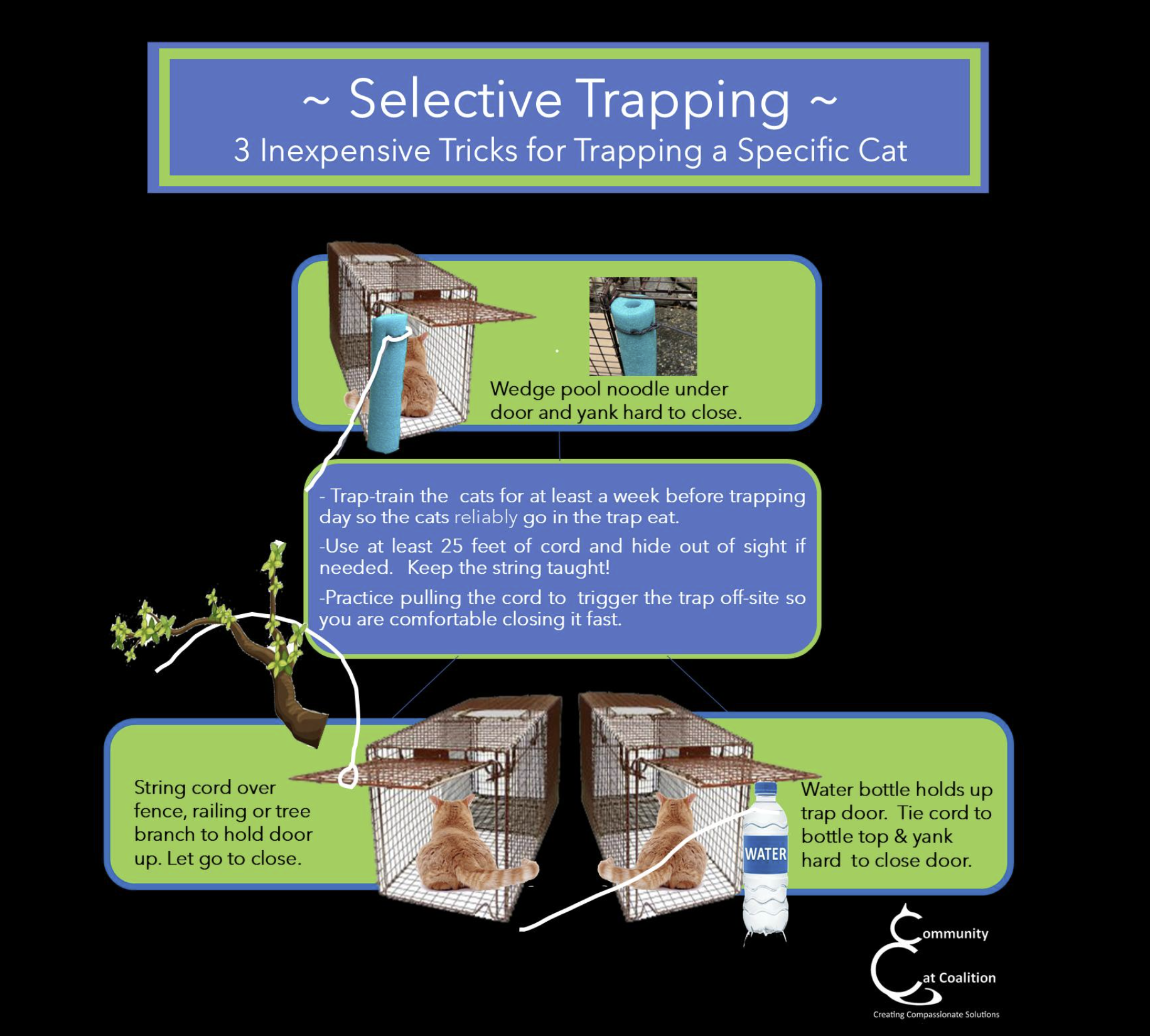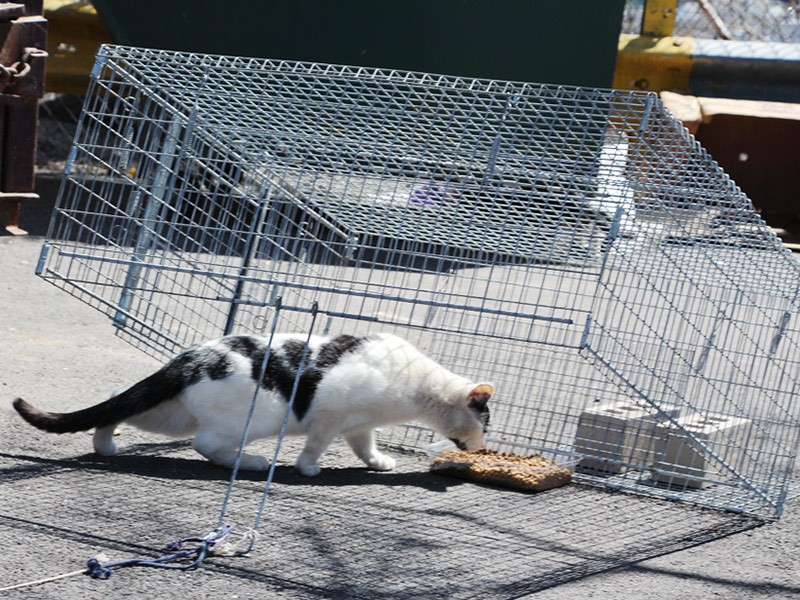TNR Tips
How to trap a feral cat! Trap-Neuter-Return is the tried and true method for humanely managing cat populations. Care about kittens? TNR is one of the best ways to prevent kitten euthanasia, as the majority of kittens euthanized in shelters are those who are found outside (feral or orphaned!). By the Kitten Lady!
Favorite Tips
1. Trap handle covers: cut an old garden hose into 4” segments with a hacksaw, slit one side with scissors, and slip over the annoying wire trap handle.
2. Waterproof liners: Ask at Lowe’s or Home Depot for discounts on vinyl flooring remnants from their big rolls. Cut into 8” x 23” pieces and use as a foundation under the newspaper you put in the trap. If there is an old-style Tru Catch with a chain at the front of the trip plate, you will need to cut a small notch for it.
3. Cardboard “mess pad”: Place a 7” (approximate) in width piece of cardboard over the newspaper liner when trapping. After the initial commotion, it can be slid out from under the cat, leaving the clean newspaper underneath. Added benefits are that it adds a little weight to the trip plate and helps keep the newspaper liner in place if there a breeze.
Access the full document of TIPS from our volunteer trappers here!
And check out this video: Updated for 2023! Trapper Tips And Tricks Presented by Neighborhood Cats
Utilizing Technology
Check out this video on how to make an inexpensive remote trigger for your gravity trap!
How to use a Drop Trap
How to use a Drop Trap
Also consider leaving your drop trap flat on the ground but propping the transfer door open using something like a 6” piece of small round PVC tubing that is attached to a cord. Just pull the cord and release that door when you have the cat(s) you want to catch!
Check out the Bottle and String Method from Flatbush Cats! It is especially helpful when trapping kittens. Instead of a bottle you can use a stick, or even a piece of a pool noodle with a string/cord inserted through the inside of the noodle and tied in a knot.
Transferring To & From a Carrier
Transferring a cat from a trap to a carrier and from a carrier to a trap
Food Grade Diatomaceous Earth (DE) can be very helpful for community cats. Some uses include:
Sprinkle it around and in feeding stations and in shelters to kill ants and fleas.
Apply topically to control fleas or mix in wet food to rid cats and kittens of many parasites including tapeworms.
Sprinkle it around your trap and under the bait dish to keep ants out of the bait.
ONLY use “Food-Grade” and avoid breathing it in while you are applying it.
Post-Surgery Care
Here is some helpful post-surgery care information from Feral Cat Focus of WNY including the following: Cats usually need to be held for 24 hours after surgery, depending on recovery speed. Male cats and often females can be returned to the trapping site 12 to 24 hours following surgery, as long as they are fully awake and do not require further medical attention.
It is not cruel to leave a feral cat in their trap – even for a few days if needed. Feral cats don’t react like a tame cat. They tend to remain still and in one place. They prefer to be in tighter, darker spaces rather than wide open enclosures (they feel more secure).
And this is what Alley Cat Allies provides on Post Surgery Care.
Thinking about starting a TNR program?
How to start a Feral Cat Program from Maddie’s Fund
How to Implement an Organizational Trap-Neuter-Program from Alley Cat Allies
And here is what the Humane Society offers on How to Start a TNR Program
And from SPAY USA:
We feel that the feral cat problem will best be solved at a grassroots level, with each city, town or county developing its own Cat Project. Many models exist already. These Cat Action Teams need to
Find veterinarians interested in helping solve the problem and willing to learn the techniques of safely spaying/neutering these wild creatures.
Recruit and train volunteers to trap cats.
Establish guidelines and procedures for aftercare and long term maintenance
Educate local officials about the problem and the solution
Visit our page on Starting a TNR Program for a lot more information!
Starting a TNR program sometimes starts small… one person, one trap, one compassionate veterinarian.
How to Talk TNR - These four tips can help you win over TNR resisters, whether they are pet lovers or not. From ASPCApro
Check out A Guide to TNR and Colony Care, provided by the ASPCA, Alley Cat Allies, and The Mayor’s Alliance for NYC’s Animals
Tips from Community Concern for Cats. Here’s an excerpt: “On the evening you plan to trap the cat and bring it home before surgery, place two pieces of wood (2 x 4) on top of several layers of newspapers. Placing the trap on the wood elevated above the newspapers allows the inevitable mess of food, urine, and stool to fall through the wire and keep the cat a little cleaner.”
From Austin Animal Center: What to do if you find a cat or kitten
Check out Humane Cat Trapping Instructions for TNR from Best Friends.
There may be times when a feral or semi-feral cat needs to become an indoor cat, such as when it’s health no longer allows it to safely live outside. Here are some tips from The Catnip Times on how to tame a semi-feral cat.
The Kitten Lady is a great source for tips on socializing feral kittens. Be sure to also visit our Kittens Page for more info on what to do when little furry ones are involved in your TNR efforts.
From Williamson County Regional Animal Shelter (WCRAS): Line the bottom of the trap with newspaper, cardboard, or towel
Do not leave unattended for protection of the cat.
Remove cat to a safe place once trapped. Consider placing food bowl inside a slightly larger bowl of water to discourage ants.
Cover trap with sheet or towel for cats protection. Do not bring wild cats without a cover.
Never move trapped cats in an enclosed trunk or bed of a pickup truck. If you have a transport it in the back of a truck make sure it is secure and covered properly.
Cats will be returned to the trap after surgery and should be kept in a safe place one night after surgery to regain its functions.
Provide food and water as soon as you get home with the cat. Release cat only into its home territory or follow relocation guidelines.
When you need to use a drop trap for hard to catch cats…
If you are still unable to trap a cat or if the cat has learned how to steal bait without springing the trap, consider using a drop trap, which does not rely on a trigger plate to close the trap door. Drop traps allow you to catch a cat without having to force him into a confined space. The drop trap falls down over a cat (when triggered by you with a rope) eliminating the need for kitty to step into a narrow opening. Using a drop trap is often a last resort, because it either requires you to build or purchase your own or find one to borrow. Using a drop trap normally requires the help of another trapper. Visit NEIGHBORHOOD CATS for instructions on how to build a drop trap or option to purchase a pre-made trap.
Watch Jackson Galaxy in action as they try to trap this trap-savvy mama cat. And check out the use of the drop trap!
And check out this Camo Cover for that trap-savvy cat! Available on Amazon for under $10.
Trapper Phaedra HIGHLY recommends Squid Fish Sauce for bait. You can also use it to dribble a trail into the trap to help entice that extremely difficult-to-trap cat! Fish Sauce can be found at many locations as well as on Amazon!
Humane traps help caretakers catch cats before they undergo spay/neuter surgeries. Neighborhood Cats
And here’s an article worth reading from July 1, 2016
How to help your neighborhood's feral felines: tips for keeping neighborhood cats safe
Caring for feral cat colonies takes a village
Julie Falconer






